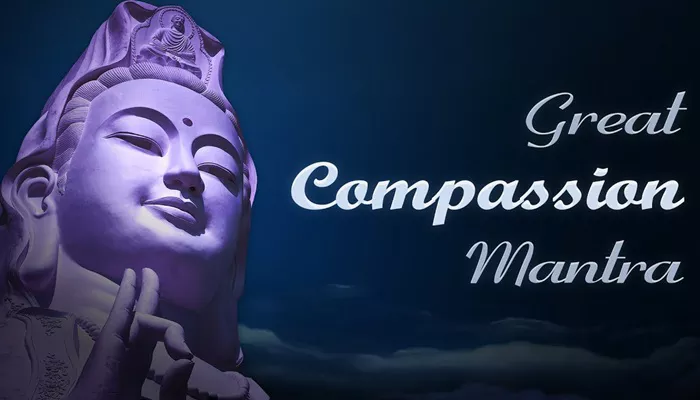The Great Compassion Mantra, known in Sanskrit as Dharani of Great Compassion (Mahā Karuṇā Dhāraṇī), is one of the most important and powerful mantras in Buddhism. It is closely connected to Bodhisattva Avalokiteshvara, also called Guanyin in Chinese tradition, who embodies compassion for all beings.
This mantra is widely chanted by Buddhists worldwide to invoke mercy, protection, and blessings. It holds a deep spiritual meaning and offers many benefits to those who sincerely recite it.
What Is the Great Compassion Mantra?
Origin and Background
The Great Compassion Mantra originates from the Mahā Karuṇā Dhāraṇī Sūtra, a sacred scripture that teaches the power of compassion and loving kindness. This mantra is a long and complex chant made up of many syllables, believed to contain the essence of Avalokiteshvara’s compassion.
In Buddhist tradition, a dhāraṇī is a phrase or series of words that carry spiritual power, often used to protect the mind and body and to help overcome suffering.
Meaning of the Mantra
The literal translation of every syllable is difficult because the mantra is mostly composed of sacred sounds and symbolic words. However, its overall meaning is the invocation of boundless compassion and the wish to relieve suffering of all sentient beings.
Reciting the mantra helps cultivate a compassionate heart and connects the practitioner to Avalokiteshvara’s vow to assist all who suffer.
Structure and Composition of the Great Compassion Mantra
The mantra is long and consists of many syllables that may seem unfamiliar. However, each part has symbolic meaning. It contains invocations, praises, and requests for protection and blessings.
The mantra starts with salutations to Avalokiteshvara and ends with the repetition of sacred seed syllables believed to purify and protect.
Benefits of Reciting the Great Compassion Mantra
Spiritual Benefits
- Develops Compassion: Regular chanting opens the heart to empathy and kindness towards all beings.
- Purifies Negative Karma: The mantra cleanses past misdeeds and harmful actions, helping the practitioner move toward enlightenment.
- Strengthens Mindfulness: Reciting the mantra helps focus the mind and deepens meditation practice.
- Protection: It is believed to shield the practitioner from physical harm, spiritual obstacles, and negative energies.
Physical and Emotional Benefits
- Calms the Mind: Chanting can reduce anxiety, stress, and bring emotional balance.
- Healing Energy: Many practitioners report improved health and well-being by connecting to the mantra’s healing vibrations.
- Improves Concentration: The rhythmic repetition sharpens focus and mental clarity.
How to Use the Great Compassion Mantra
Preparing for Chanting
Before reciting the mantra, find a quiet place where you can sit comfortably. Cleanse your body and mind by washing your hands and face if possible. It is helpful to calm your breath and set a sincere intention to benefit all beings.
Correct Pronunciation
Since the mantra is in Sanskrit or classical Buddhist phonetics, it can be challenging for beginners. Listening to experienced monks or teachers recite it can help. Using a written guide with phonetic pronunciation is also useful.
Frequency and Duration
You can chant the Great Compassion Mantra daily or during special occasions such as meditation sessions, Buddhist festivals, or times of distress. Some practitioners chant it hundreds or thousands of times, using a mala (prayer beads) to count.
Mindful Chanting
Chanting should be done with full attention and respect. Focus on the sound, meaning, and intention behind the mantra. Visualizing Avalokiteshvara or imagining the spreading of compassion can deepen the experience.
Common Misunderstandings about the Great Compassion Mantra
Is it Just a Chant?
Some people think the mantra is just a repeated phrase without meaning. In reality, the mantra is a sacred tool to cultivate compassion and wisdom. The power comes from sincere faith and practice, not just repeating sounds mechanically.
Must You Understand Every Word?
While understanding the meaning enhances the experience, it is not necessary to know every syllable’s meaning. The mantra’s sound itself has protective and transformative power.
Stories and Experiences Related to the Great Compassion Mantra
Many Buddhist masters and practitioners share stories about how chanting this mantra brought peace, healing, and miraculous help. For example, it is said that Avalokiteshvara’s compassionate presence can manifest to assist those in danger when the mantra is recited sincerely.
How the Great Compassion Mantra Connects with Daily Life
Even outside formal practice, the mantra can remind us to be kind and patient. It encourages us to see others with compassion and to act with a loving heart in everyday situations.
In Difficult Times
When facing challenges or pain, chanting the mantra can provide comfort and strength. It helps us remember that compassion is a source of healing for ourselves and others.
In Relationships
The mantra inspires forgiveness and understanding, improving our connection with family, friends, and community.
Conclusion
The Great Compassion Mantra is a powerful practice for anyone who wishes to cultivate compassion, peace, and protection. Through sincere chanting, we align ourselves with the great vow of Avalokiteshvara to relieve suffering everywhere.
Remember, the true power of this mantra is not just in the words but in the loving intention behind them. As you continue your practice, let compassion grow in your heart and in your actions.

